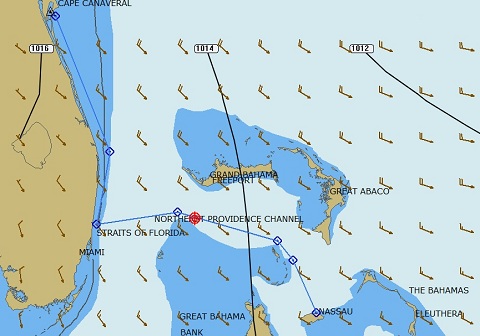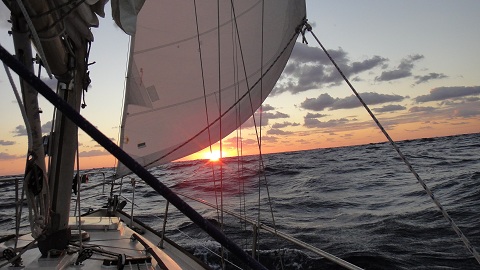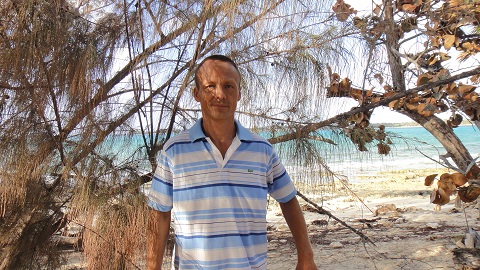
Sailing Vessel Beruta Ship's Log
Port Canaveral, Florida, USA - Nassau, New Providence, The Bahamas

6 November 2012
Summer break is now over. At last, I'm back on my boat. And back to work. After I had "fixed" the rudder bearing in May, I realized that it was not done properly. I could hardly turn the tiller. The reason for that was inaccurate shoe drilling on Curacao. The man there had drilled it at the wrong angle. Now when Kurt here was making the pin for it, he made it even worth by increasing that angle. The cooperation of two professionals made me repositioned the hinges, i.e. the shoe on the keel and its counterpart on the rudder, to align it with three other rudder bearings (at the deck, at the hull bottom and in the middle of the rudder). See the picture here.
While I was doing all these, hurricane Sandy passed by in about 200 miles offshore. We only had a tropical storm. People said that the cold front saved Florida from the disasters of the northern states. Nevertheless, my wind generator quit. The wire that connects to the brush corroded and fell off. Ok, easy to fix.
The batteries left without charge for 6 months, all died, you knew it, right? The raw water pump sited in salt for the same period of time, caused me to buy new bearings and lip-seal again.
There were other miscellaneous repairs, regular diesel maintenance and innovations here and there. For example, I installed the second primary fuel filter with tees and valves to switch to it in seconds if the first one gets clogged. If it had been done in the beginning, it would have saved me lots of headaches. I also replaced the burned out bulb of my windgenerator divert load with 1-Ohm 300W resister and glued a little hole on the dinghy.
Anyway, November 6, just before another cold front, I wanted to be in the water to use westerly wind for sailing to Nassau. There were many things to do, so I was running around all morning and afternoon to finish preparations for the departure: provisioning on my bike, replacing old batteries, getting four cans of fuel, etc. The launch was scheduled for 3 PM. Surprisingly, I was done by that time and let marina folks put Beruta on a travel lift.

At around 4 o'clock I picked up the laundry, had a shower, paid the bills and jumped aboard with a bottle of Miller. Primed the PSS shaft seal, checked for water leaks, warmed the engine and off I went.
21:45 UTC. Engine at 2400 rpm. To charge 3 new hundred amp-hour batteries, I figured that I needed to run it for about 14 hours. That's 7 gallons of diesel! What a shame to motorsail in good 15-20 knots wind! Oh, well, I'm happy anyway being back on water. Hoisted half main, then jib. SW wind, starboard 60° to the wind. SPG 6.5-7 knots. Course 155° M. Atmospheric pressure 753 mm.
7 November 2012
00:00 UTC. Course 160° M. Need to go south, heading 60° to the wind. Reduced engine rpm to 1800.
00:30 UTC. Course 165° M. 60° to the wind. The low pressure center in passing north of my position. Scary lightnings are flashing on the horizon.
01:10 UTC. Course 170° M. 60° to the wind. 20 knts gusting to 23.
02:25 UTC. Course 172° M. 90-120° to the wind. Wind is shifting to the north, meaning that the front passes over, still 20 knts gusting to 22.

02:35 UTC. Motosailing downwind at 120-150° to the 15 knt wind. Set up the preventer.
09:00 UTC. Wind increasing again to 20-23 knots.
10:40 UTC. Course 180° M. 90° to the 15-20 knt wind.
12:00 UTC. Stopped the engine.
14:00 UTC. Course 195° M. Reaching at 20 knts. Atmospheric pressure 756 mm. Sunny and cold.
16:00 UTC. Course 220° M to get closer to the shore to avoid the 2 knts current at 9 miles offshore.
My original plan was to go straight to the Bahamas despite of the sailing guides recommendation go south along the coast of Florida as far as Fort Lauderdale or even Miami. They reason it by a short distance crossing the Gulf stream. At the same time, it is the narrowest part of Florida Straits, hence, the strongest current (up to 7 knts!). When I was sailing the opposite direction straight to Port Canaveral from the Bahamas in May, I experienced only 3 knts in this much wider area of the Gulf stream. In northerly wind, it could make a difference! The only problem with going to the Bahamas directly would be sailing dead downwind and that is very annoying. Therefore, I decided to follow the beaten path.
I had very little luck in my attempt to escape the stream. I was still getting 1 to 2 knts of current. Sailing at times almost 8 knts over water, I was not even close to 6 knots over ground and that was just 1.5 mile from the coast. When I saw Fort Lauderdale on the horizon the wind calmed down, so the speed. I connected to an open wifi spot to get the latest GRIB files. Also, chatted with my boatfriend Lenny from Titusville, Fl. He would join me in the Bahamas in December. Lenny suggested me to stop over night at Boca Raton lake for rest. I declined. I would have missed the good wind for crossing the Straits. Next day it would shift to the north and make waves probably worth.
Port authorities called me on VHF to announce that the cruise ship was about to exit the channel, probably thinking that I had been heading to the port. At 17:30 local time the huge cruise ship did appear in the last sun rays. At this time I gave up moving south and made a 90 degree turn to cross the Straits of Florida.
As you can see on the picture, there are lots of dolphins around Fort Lauderdale.
I had very little sleep last night, therefore, after I lowered the main due to unstable downwind course, which is more or less dummy autopilot issue, I crashed into my bunk. At night, I woke up 2 or 3 times to correct the course. It wasn't bad, I meant the current and the NW wind. Not too scarry, even that it was blowing 20 to 25 knots.
8 November 2012

By the morning I was in the Northwest Providence Channel with the Great Bahama bank on my starboard and still facing 2 knots of up current! Damn it! Only an hour or two after the sunrise it subsided and then disappeared.
Now I had two options: sail over the bank or go around the Berry islands. The first one meant shorter distance but not much and crossing the bank downwind which was not a very good idea especially at night. So I chose the second one. The longer path was actually allowing me to get to Nassau at sunrise.
I was rounding Berry islands at night. Sailed close to the shore in a hope to get a free wifi signal. But no luck, the only available provider was a sattelite and quite expensive.
One last night to go. The wind was shifting to the east when Beruta was turning south. Very good! That was the great plan to leave US one day prior to the front. It meant that all the time you'd be sailing with the wind.
9 November 2012

Nassau. There it is. Big touristic place with a Paradise island to my portside. First, I wanted to get into the harbour and check around. But then I realized that if I did not like it there, then getting out of it, would have been against the 25 knt wind and big waves. No, thanks. Let's go to some place quieter than this Bahamas' capital.
I read on the noonsite.com that there were two more anchorages in New Providence. Both on the west side. The first one was to the left of the channel that goes to the private Lyford Cay marina. It was behind the reef but exposed to the wind and no boats there. The second one was in the Cliford Bay that was protected from all directions except the west. In the forecast there was an easterly wind for the rest of week and into the next one. Good then.
I had two charts: Navionics on the chartplotter and C-map on my laptop. They had different opinions about entering the bay. According to the chartplotter, the best way was to do it from the west but laptop was showing a much more shallower depth there. Hm...
Ok, I decided to trust the Navionics, since it did look better on the west side. The depth was not exactly as it said but I was able to pass into the bay without a problem. I lowered my jib first, of course and was motoring agaist the wind slowly.
Good protection indeed and very fast free wifi, not to mention the garbage bin ashore in the Cliford National Heritage Park but not a single boat in the anchorage! Maybe it is not a season? Well, I read that most sailors from the states spent a winter time in the Bahamas. Maybe on the other islands?

Anyway, I dropped my CQR in about a meter of water under the keel. Tides here were not huge, less than a meter.
Time to go ashore and see what the immigration are going to tell about reentering the Bahamas. Launched the dinghy and outboard. Installed the lock on it as I read that here it was a must. Filled the motor with gasoline and... it did not start... Crap...
The shore was not too far but it was really windy and might not be reachable by rowing. On the other hand, it was better to fix the engine anyway.
First, I thought that the stop button was not working and cut the wires to make sure that it was not it. So silly of me. Of course, it was not. I couldn't see if there was a sparc because it was a lot of light. While waiting for the dark, I decided to remove the carburator and clean it in the gasoline. It had to be one or the other. Meanwhile, I noticed that my anchor was not holding. Well, that was expected, because it did drag when I had been pulling with the engine. I just wanted to drop the second anchor from the dinghy!
Ok, no other choice except to re-anchor. Dropped it in a different place, still dragging. Damn it. Put on the mask and the fins and went snorkelling. Wow, it was cold! I tried to dig the anchor into the grassy bottom as much as I could. Hopefully, it would hold till the morning as it was already getting dark. I set the anchor alarm on the chartplotter (the wind was blowing 20-25 knots) and went to bed.
10 November 2012
As they say in Russia the morning is wiser than the evening. I woke up when it was still dark and checked the motor for the sparc. Yes, it was there. Finished cleaning the carburator and fixing the stop button. Put everything back together and vu a la - it started! Thanks god!

Now it was time to dig in the anchor. I got my big brazillian knife, wet suit, mask and fins and jumped into water for some fun. I probably spent 15 minutes or so cutting a hole in sand and grass for the CQR. Ok, much better now!
I was not able to go ashore again this day as I spent all the time cleaning the boat. I washed the cockpit, topsides, the deck and the railing. Still need some time to arrange everything inside. Well, we'd see. Not even sure that immigration was open on a weekend.
Clearance procedure and requirements in the Bahamas
As various resourses say, in New Providence you may clear in at the Customs and Immigration office located east of the cruise ship terminal in Nassau Harbour or in any marina on the island. Of course, you must be in the marina in order to complete the formalities, not on the anchorage. The customs office has its own dock (look for the yellow tower - it is on the east side of it). Despite the fact that I had the valid annual cruising and fishing licenses I had to check in again because I was in the US for more than 3 months. Clearance-free re-entry the Bahamas is allowed within 3 months only. Otherwise, it is $150 for a sailboat of my size.
You must report an arrival to the Bahamas within 24 hours. Because I was on the boat fixing the outboard engine and not really had stepped on a shore, they might have considered me in transit or whatever. Anyway, November 12 I went to the airport on a bike to rent a car and get to Nassau customs office where I was explained the above regulations. They insisted me bringing the boat either to them or to any marina. The anchorage in Cliford bay was not a port of entry in their opinion.

I got back to Beruta by 3 PM. The closest marina on the south coast was in Albany but it was not on any of my charts! I saw the AIS markers in that area but they were on a shore. So there must have been a channel across the reefs. I searched the Internet for the Albany marina and found a web site that allowed me to make a reservation there. It also had a chart (more like a satellite image where I could clearly see the channel). I placed its waypoints to my Raymarine charplotter and motored for about an hour to the marina. Hell, it was expensive - $4.5/ft. They didn't even have a shower!
An immigration officer came the same evening but a lady from the customs showed up only next morning. I extended the car rental for another day. It was also not cheap - $66/day from Budget. Shopped around, everything was unbelievably expensive, dropped the car at the airport - they had refused to pick me up and drive back saying that it was too far. Obviously, 12 minutes drive is far for an overbooked company. I left the marina at dark following my track back to the Clifton Bay anchorage. Setting the anchor this time was not only with a knife but also with a torch!
19-21 November 2012. Cliford Bay - Nassau - Cliford Bay
15 miles trip to Nassau was not satisfactory mainly due to the fact that there was no dinghy dock around. The marina where people had used to leave their tenders was renovated; therefore, most folks dragged them ashore near another marina in a hope that nothing happened to them. I followed the sailors, ran some errands and returned to the boat in a couple of hours. The anchor was holding great but there was a strong current in the harbour that affected Beruta more than a wind. Also, daily traffic and the absence of the Internet made the stay in Nassau unpleasant. The next morning I sailed back to the quiet Cliford Bay anchorage.
All pictures from The Place are on Google Photos.


